Blue mosquitos and blue donkeys
Ethiopia had been on our list of countries to explore for a long time. Jude remembers seeing pictures of the Lalibela churches more than 20 years ago. When we moved to Kenya, Martina was still living in Ethiopia, but as we were settling in, and she was on her way out, a trip didn’t happen. We tried once more last year, but had to cancel due to Jon’s work.
When finally planning the trip, we divided Ethiopia into two halves, the north and the south. And we were going to spend a week in each. It didn’t give us a lot of time as Ethiopia is huge, but we had picked a few spots we really wanted to see and ignored the rest. Due to the vast distances between cities in the north, and the generally non-existing or crumbling infrastructure, we decided to fly around the north. It was like a posh version of backpacking, where you take the plane instead of the bus.
Our main focus in the north of Ethiopia was the Danakil Depression with its volcanic activity and surreal landscapes, the three ancient capitals of Ethiopia; Axum, Lalibela and Gondar, all places of historical and religious interest, and the Simien Mountains for a dose of nature and wildlife (wait for our post ‘The hunt for the red wolf’).
In the south we wanted to see some of Ethiopia’s vibrant tribes, still living as they have for hundreds of years (you can read about this in ‘Tribal Matters in Ethiopa’, which will be published next), and of course we couldn’t go past the Bale Mountains for some more interesting flora and fauna (which will also be written about in ‘The hunt for the red wolf’).
Danakil Depression
The Danakil Depression is created through the pulling away of three tectonic plates, leaving the area 125m below sea level, making it the sixth lowest location on Earth. Lowest is the Dead Sea in Jordan (-414m), followed by Lake Assal in Djibouti (-155m), Turpan Pendi in China (-154m), Qattara Depression in Egypt (-133m), and Vpadina Kaundy in Kazakhstan (-132m). Despite not being the lowest, it is however the hottest inhabited place in terms of year-round averages with an average daily temperature of 41.1 degrees. All in all not a very hospitable place to live.
In Addis Abeba, the capital of Ethiopia and our first point of entry, we had checked out Lucy, the 3.2 million year old girl, as well as many other ancient hominid fossils in the National Museum. Very impressive. They found Lucy in the Danakil Depression in 1974. It was high on our list of must-see places, not for being considered the cradle of hominids, but because of the otherworldly scenery with psychedelic colours.
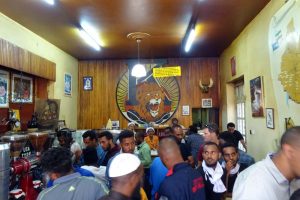
Jon having a coffee in ToMoCa – coffee was first discovered in Ethiopia in the 9th century, and having a cuppa in Addis Abeba’s oldest coffee shop is a must. We loved the way you order and pay at the counter in the front and get a coloured token to give to the barrista in the back. No take-away here, you drink it on the premises, making it a very environmentally friendly cafe too.
In the Danakil Depression we hiked up the active volcano Erta Ale. Several years ago it had an impressive lava lake, similar to the one we saw on Nyiragongo in the DRC. However, after an eruption in 2017, the lava levels sank, and the crater is now filled with smoke. You get an occasional glance of the orange-hot glowing lava several metres down when the wind blows the smoke away, but it is no longer worth the effort of getting there in our opinion. But we loved spending the night on the crater rim underneath the very bright, moonlit sky.
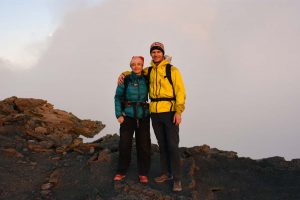
Jude and Jon at the edge of the Erta Ale volcano lake, the walk up the volcano is covered in rubbish
We also floated in very salty Lake Afrera (like our swim in the Dead Sea in Jordan), before rinsing off in the hot, fresh water springs right next to the lake. On the drive to Dallol we are lucky to see one camel caravan leaving the salt flats of Lake Assale, the camels loaded with slabs of salt (ghelao), each weighing about 8kg. The new road means there are few caravans nowadays to transport the salt, trucks are now used instead, bringing an ancient tradition to an end.
And then we were finally approaching our next volcano Dallol, the main reason for our visit to the Danakil Depression. Dallol is a collapsed volcano 48m beneath the sea level, making it the lowest not-submerged volcanic vent in the world. It is very unassuming when you arrive. A gentle slope of dried, brown-orange mud blobs leads to the outer-worldly scenery. Everything around you is bubbling, spitting or smoking. The colours everywhere are bright and unusual, and add to the surreal landscape. This is truly spectacular, every area being more amazing than the previous jaw-dropping, oh-wow section.
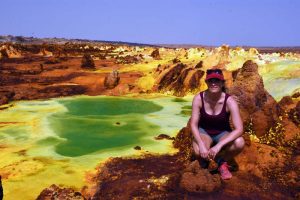
Jude in Dallol – the colours are truly psychedelic – they even found life in a pool where the acidity was measured as zero pH. The pools are the most acidic places in the world where life has been found.
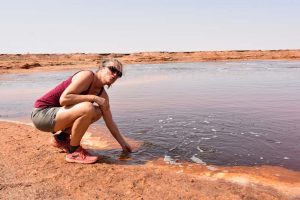
A quick stop at Gaet’ Ale, also known as the Yellow Lake or Killer Lake, with salty, warm water (50-55C), oily to touch and with a pH of around 2. It is rich in carbon dioxide which kills insects and birds that come too close. The carbon dioxide bubbling up, creates a layer low to the ground as it is heavier than normal air. This layer of approximately 30cm suffocates small animals and birds that breathe in that layer.
Axum
Apparently the son of the Queen of Sheba and King Solomon, emperor Menelik I, brought the Ark of the Covenant, containing the two tablets with Moses’ 10 Commandments, to Axum. The Ark is supposedly still kept in the local chapel, making Axum a very religiously important pilgrimage destination.
Axum is Ethiopia’s oldest city, dating back to 400 BC, and one of the oldest continuously inhabited places in Africa. The town is now widely known for its stelae. One of them, the ‘Great Stele’, is the biggest stone ever cut in the world and moved to its location, measuring 35m in length and weighing 500 tons. Unfortunately it has fallen over and is lying in bits on the ground. We ambled amongst the grandeur of these ancient monuments of past kings and other important people with Mengistu, our guide, who was very patient with our lack of religious knowledge.
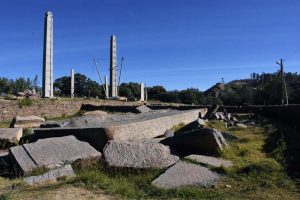
the three largest stelae in Axum:
the broken stele in the foreground is the 33m long ‘Great Stele’, it probably fell when they were erecting it
next is the 24m tall ‘obelisk of Axum’ which was taken to Italy as a war trophy in 1937, and returned and re-erected in 2008
the largest unbroken monument is King Ezana’s stele, 21m tall, now supported by cables to remain standing
The bath of the Queen of Sheba can still be found in Axum, as well as the ruins of an Axumite palace which some believe also once belonged to her. It is now a ruin and only has gravesites left beneath it. Afterwards our guide took us to a tiny little, unassuming shack. We didn’t know what to expect, but were impressed to find a stele here from King Ezana, the Ezana Stone, engraved in three languages with the account of him converting to Christianity and some of his victories. The farmer who found the stone right there had found the equivalent of the Rosetta Stone, and had to give up the land to display it.
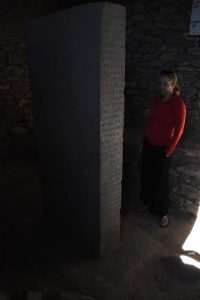
Jude and the Ezana Stone – King Ezana wrote of his victories in three languages, a bit like the Rosetta Stone
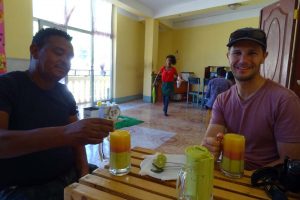
Jon and Mengistu enjoying a ‘spri’ – a layered drink of pureed fruit (avocado, papaya and mango), Jude is having an avocado juice.
Lalibela
In this ancient town we discover several rock-hewn, monolithic (made out of one rock) churches built in the twelfth century. Each one of them is unique, but they are all beautifully handcrafted. Some are decorated with paintings, but all are important places of worship until this day.
We’re not religious, but Lalibela is impressive, no matter what your faith is. We were lucky with Dasta, our guide, who showed us the impressive, rock-hewn churches, lead us through narrow passage-ways, explained the significance of things, pointed out interesting details, and even sang us a hymn as we walked through one of the underground tunnels in complete darkness.
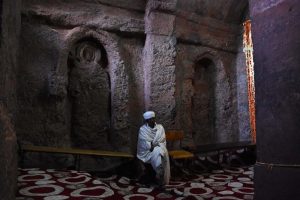
a monk in silent reflection between some of the seven saints carved in the walls of Bete Golgotha – the only church in Lalibela where women are not allowed to enter
We spent two days walking around, mingling with the religious pilgrims who were starting to arrive for the Ethiopian Christmas, which is not celebrated on 25 December each year, but on 7 January. The Ethiopians are also seven to eight years behind our Gregorian calendar as theirs is based on the Coptic calendar which uses a different method to calculate the annunciation of the birth of Jesus. The Ethiopian calendar has 13 months, twelve have 30 days each, and the thirteenth month has 5 or 6 days (6 in a leap year).
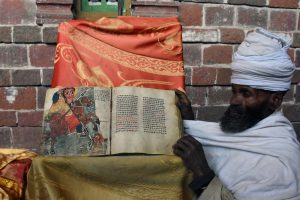
a priest proudly shows an ancient book made of animal skin in Na’akuta La’ab – a church inside a natural cave just outside Lalibela
The two most impressive sightings for us in Lalibela were the church of St George, which is the image Jude saw so many years ago. It is truly impressive to look down on a church in the shape of a cross, and realise it was hacked out of the rock you are standing on. The other thing we loved were the soaring lammergeyers close to the track we stood on. We had a good look at them, even without binoculars.
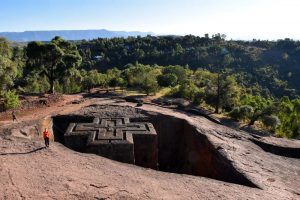
Jude next to the rock-hewn church of St George in Lalibela – the church she saw on a picture as a teenager
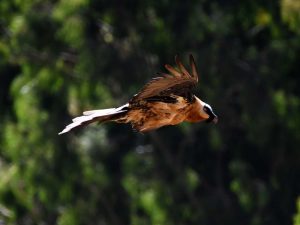
a lammergeier soars past – it is also known as the bearded vulture or the bone breaker as it drops bones from 50-150m onto rocks to break them so they can be eaten as most of their diet consists of bone marrow. It takes seven years of learning to master this skill. They also sometimes kill live prey in the same way.
Gondar
On our way to the Simien Mountains we stopped in Gondar. Every year the Ethiopians celebrate Timkat, a religious festival celebrating the baptism of Jesus in the Jordan River. The largest reenactment is held in Gondar at Fasilides’ Bath, although it is much larger than a swimming pool, filled with water only for this day. Fasilides was the emperor of Ethiopia from 1632, and he founded Gondar, establishing it as Ethiopia’s capital. They were preparing the baths for the water to pour in, but we were regularly distracted by the birds in this green garden as Emanuel, our guide, was useless. We even spotted a white-cheeked turaco.
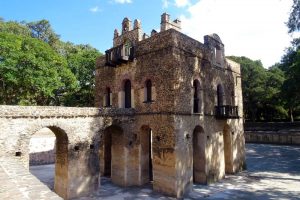
they were fixing Fasilides’ Bath in preparation for Timkat – a religious festival where they celebrate the baptism of Jesus in the Jordan River
Fasilides is also the one who built the Royal Enclosure, Fasil Ghebbi, where you can still see his castle, a palace, a huge banqueting hall with stables opposite, a library and three churches. They also have some horribly small cages where they used to keep lions, luckily they no longer do this.
Last, but not least, we popped into Debre Berhan Selassie, an 18th century church. Legend informs us that when Sudanese dervishes arrived to destroy it in 1880, an angry swarm of bees chased them away. Nowadays it is known for the 135 cherubim (sort of angels looking after God) looking down on you from the ceiling, rows and rows of them. It is a charming, quite small church, very dark inside, which looked more like a house because of its thatched roof. We found some more birds in its garden to keep us entertained, as Emanuel again asked us “any questions?”, after not telling us anything…

some of the 135 cherubim (sort of angels looking after God) looking down on us from the ceiling of Debre Berhan Selassie
In the evening we were also finally able to hop in one of Ethiopia’s famous blue mosquitos, known in Kenya and Tanzania as the bajaji, and in India as the tuktuk. We had seen many of them buzzing around the towns, or (often) hovering in the long queues for fuel. In Ethiopia public transport is painted blue, so all tuktuks are blue and also the little vans are all painted in the same colour. The vans (little buses) are known as the blue donkeys, an obvious name if you see how much they carry, inside and out!
We used our blue mosquito to fly down the hill for a tasty dinner at the Four Sisters restaurant downtown, and were treated to some live music and dancing, much better than the standard hotel fair…
Gondar was also our gateway to the Simien Mountains National Park, where we would begin our search for the red wolf, but first we’ll show you the tribes of the south of Ethiopia in ‘Tribal Matters’ – stay tuned!

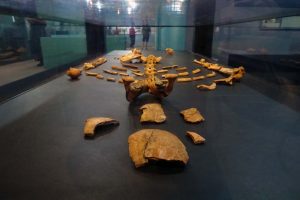
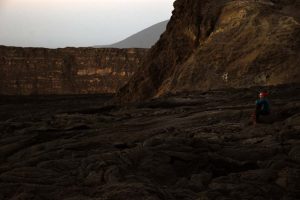
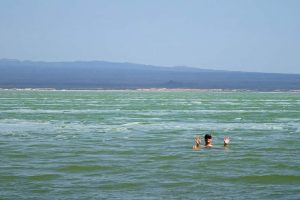
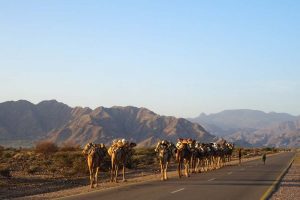
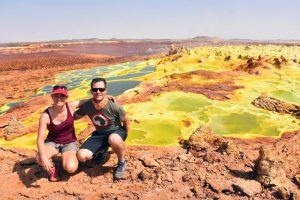
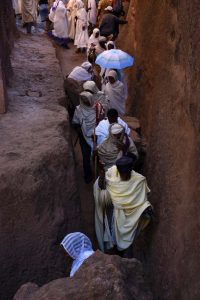

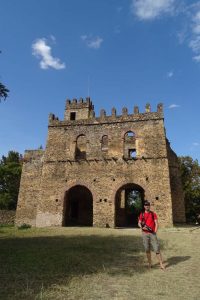
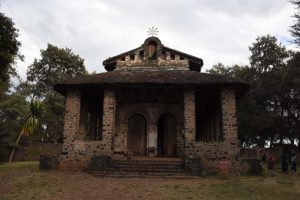
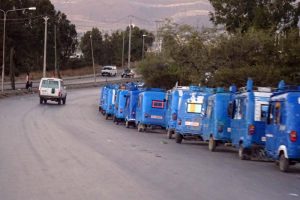
Fantastic!!! I love reading your adventures 🙂 So many fascinating places, amazing architecture, history and colours! Can’t wait for the next instalment (and till I am all shiny and new and can sneak in a trip with you somewhere!) xx
Thanks Kerry! Next installment coming soon (in about a week or so I hope). Looking forward to the day you are all shiny and new, we’ll arrange a trip as soon as you are skipping along 🙂 Jx
Envy..envy… yet again.
A very readable and interesting account.
A place now on our bucket list.
Thank you, JnJ
Thanks Ian! Happy to help you add places to your bucket list 🙂 Wait till you read the Tribal Matters and The hunt for the red fox, you will want to go tomorrow 🙂 Hope the preparations for Leichardt 2020 are all going swimmingly, we certainly hope we can join you for that!
Een indrukwekkende ervaring schat ik zo in! Volgens mij de bakermat van onze mensheid!
En weer fraaie beelden!
Dank je 🙂
Ja zeker, zeer indrukwekkend en ja, inderdaad onze bakermat. Heel interessant om allemaal te zien. Stond al heel lang op mijn verlanglijstje en aangezien we nu zo dicht bij wonen moest het er toch echt eens van komen… Een aanrader!
Another amazing adventure. Well done!
thanks Mark! Trying to keep up with your fun adventures 🙂